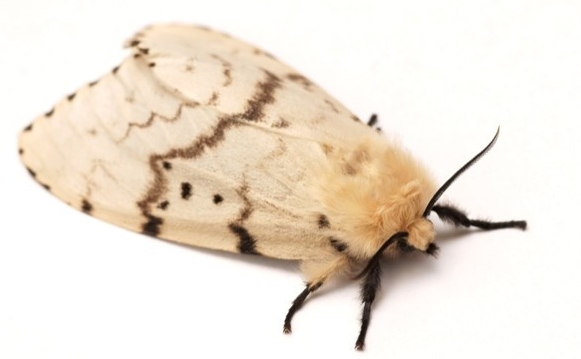The Asian Gypsy Moth (AGM) is a forest pest which is known to spread via ocean-going vessels in international trade. Attracted to bright lights, the AGM female often lay their eggs on a vessel’s superstructure and these egg masses will be carried from one port to another. In this circular MS Amlin provides an update of the various restrictions in force to prevent such spread.
Asian Gypsy Moth
AGM egg masses are covered with a yellowish scale, about 40 x 20 millimeters in size and can contain more than 1.000 eggs. The egg masses are extremely resilient and can easily be carried long distances. Vessels and cargo, such as containers, are therefore known to facilitate the spread of the forest pest. Vessels calling at Risk Area ports, mainly in the Asia Pacific between May and September, should be inspected and certified prior to departure.
Risk Areas
Animal and Plant Health Inspection Service (APHIS) of the US has appointed certain areas as “Regulated Areas” or “Risk Areas”, which are followed by other countries, as listed in Table 1.
Risk Area Specified Risk Period |
Risk Area Specified Risk Period |
East Russia |
1 Jul - 30 Sep |
People’s Republic of China |
1 Jun - 30 Sep |
Republic of Korea |
1 Jun - 30 Sep |
Northern Japan |
1 Jul - 30 Sep |
Western Japan |
25 Jun - 15 Sep |
| Eastern Japan Aichi, Chiba, Fukui, Ibaraki, Kanagawa, Mie, Shizuoka, Tokyo Perfectures |
20 Jun - 20 Aug |
Southern Japan |
1 Jun - 10 Aug |
Far Southern Japan |
25 May - 30 Jun |
Table 1 – Risk areas as defined by APHIS
United States of America (USA) and Canada
The USA and Canada have harmonized procedures to guard against the introduction of the AGM. Although the plant health and agricultural agencies of the USA and Canada are independent and have differences in their legislation, AGM risk mitigation and exclusion efforts are a joint effort.
For vessels that have called a port in a Risk Area during the specified periods, as outlined in Table 1, the following measures are required:
1. Vessels must be inspected and must obtain predeparture certification from a recognized certification body. A copy of the certificate, stating that the vessel is free of AGM life stages, must be forwarded to their USA or Canadian agents. The certificate must be issued from at least the last port of call in a regulated area that was visited during the specific risk period.

Above: Asian gypsy moth.
2. Intensive vessel self-inspections must be performed to look for, remove (scrape off) and properly dispose of or destroy all egg masses and other life stages.
3. Vessels must provide two year port of call data, at least 96 hours prior to arrival in a North American port, to the Canadian or USA agent.
4. Vessel operators are reminded to ensure that the vessels are in good condition and decks are clear of debris and unnecessary obstacles in order to allow for thorough inspection both in AGM regulated areas and upon arrival in North America.
5. While in regulated ports reduced lighting and keeping exterior doors and curtains closed may reduce the number of moths being attracted to the vessel.
Although the USA and Canada are in full agreement on the requirement for AGM pre-departure certification and vessels arriving free from all AGM life forms (egg masses, pupae, adults), due to sovereign regulations and policies, there are differences in port-of-entry processes between the two countries.
In the USA the AGM program is managed by the Animal and Plant Health Inspection Service (APHIS), of which the full text can be found here.
In Canada the AGM program is managed by the Canadian Food Inspection Agency (CFIA) of which the full text can be found here.
Australia
Australia has announced in its Industry Advice Notice No. 06-2018 of 19 January 2018 that the heightened vessel surveillance window for its ports had commenced. This window is between January and May of each year. The full text of the Notice can be found here.
In addition, the government confirmed that vessels that have visited an overseas AGM risk seaport during the 2018 AGM flight season will be risk assessed by the department to determine the need for a targeted AGM inspection on arrival. All relevant vessels will be sent an AGM questionnaire through the Maritime Arrivals Reporting System (MARS), as part of the pre-arrival reporting process.
New Zealand
New Zealand has formalized its AGM requirements through the Craft Risk Management Standard (CRMS) for Vessels, which can be found here.
From 1 February 2018, an arriving vessel will be considered a high risk for AGM if in the previous 12 months it has visited any of the Risk Areas during the specified risk periods, and requires a Certificate of Freedom of AGM. These Certificate of Freedom can be obtained via one of the approved (recognized) inspection bodies, which can be found here.
If a vessel is a high risk and does not have a valid Certificate of Freedom from AGM it will be inspected which can lead to delays. The vessel may be required to be at a location at least 4 nautical miles from land for the inspection. The operator will be responsible for the cost of inspection and any treatment or egg mass removal directed by the inspector.

